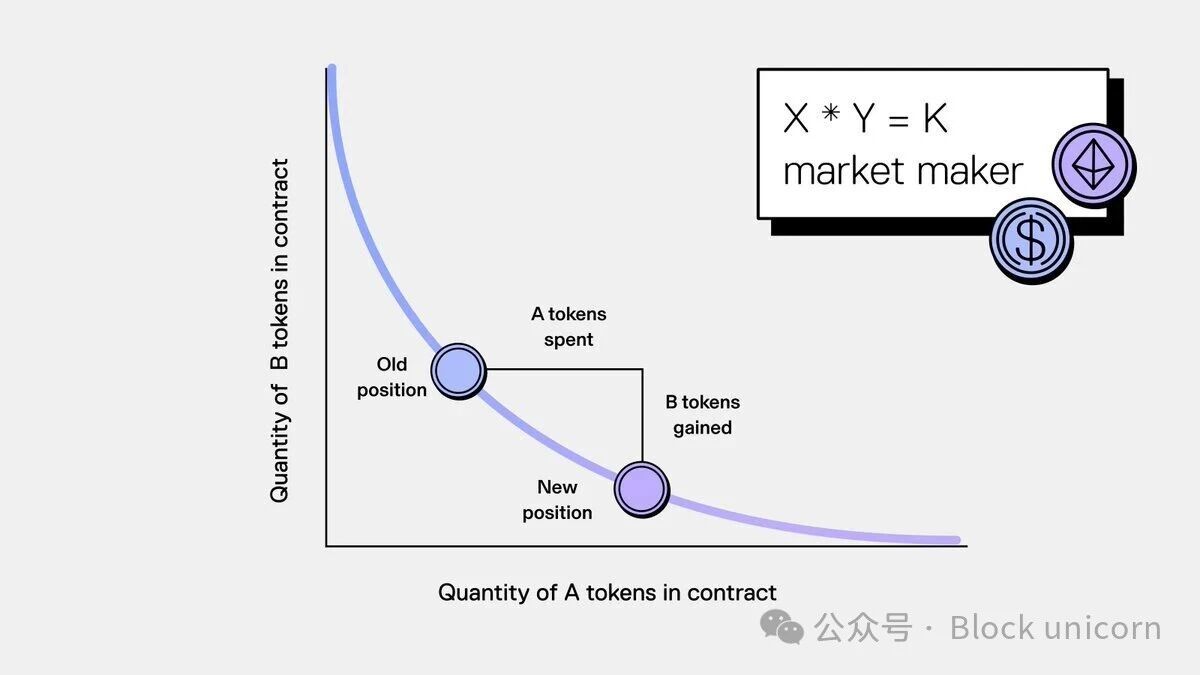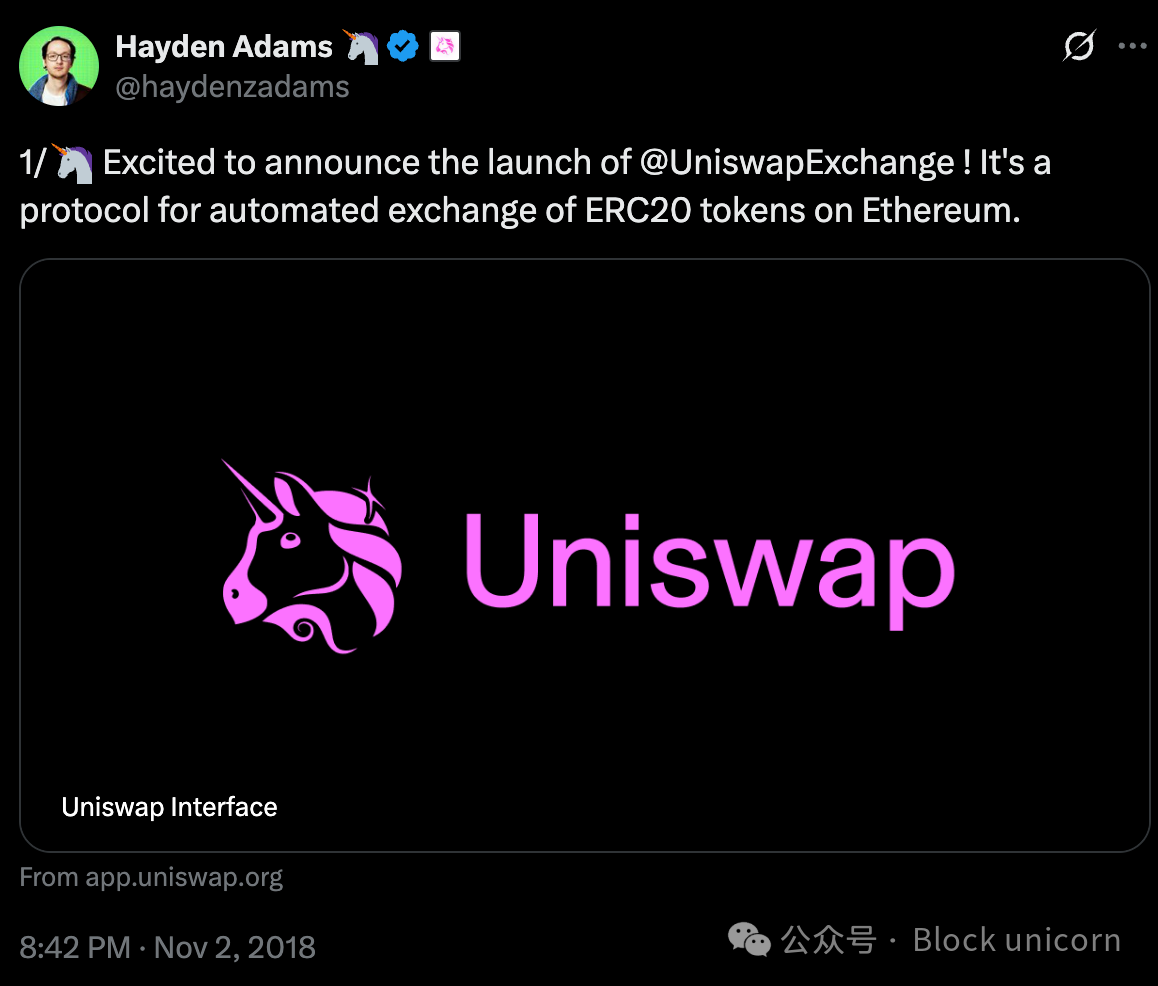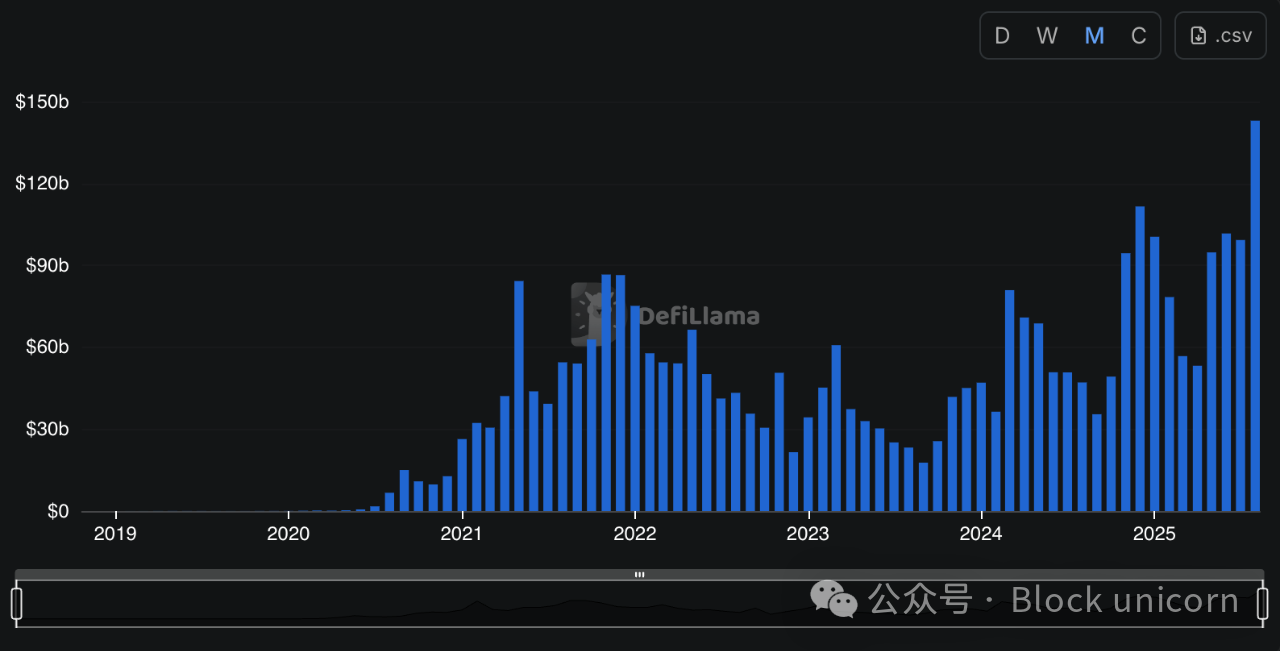Author: Thejaswini M A
Translation: Block unicorn
Preface
July 6, 2017. The HR department called.
Hayden Adams was laid off after a year as a mechanical engineer at Siemens. He felt he had never quite fit into the role of thermal flow simulation. Adams was not performing well in this position. The company was downsizing.
But the 24-year-old Adams felt a sense of relief.
He had been grappling with whether being an engineer was the right career path. The layoff forced him to make a decision he had been avoiding.
One day, his phone vibrated. A text from his college roommate.
Karl Floersch was working at the Ethereum Foundation. For years, he had been advocating for blockchain technology. Smart contracts. Decentralized applications. These were revolutionary concepts.
Adams had always tuned it out. He found it too abstract, too strange.
Now, unemployed and confused, he decided to listen.
The call lasted three hours. Floersch painted a picture of the future. Code without human oversight. Money flows without banks. Applications serving millions without corporate control.
This conversation laid the groundwork for the birth of Uniswap.
But first, he needed to convince himself that transitioning from mechanical engineering to cryptocurrency was a reasonable choice.
The Evangelist of Ethereum
What Adams saw was uncertainty, while Floersch saw opportunity.
Ethereum was still young enough that a motivated person could become an expert in a few months. The barrier to entry was low because few people understood the technology.
Adams had concerns. He had no programming background beyond basic courses. He had never built a website or written a smart contract. The prospect of shifting from mechanical engineering to software development was daunting.
Floersch provided a framework: learn by building real projects. Adams should not just take online courses but should choose a specific project and work hard to complete it. Learning would happen naturally through creation.
Floersch explained how Ethereum worked, the importance of decentralized applications, and the problems that needed solving. He described an emerging ecosystem where small teams could build applications serving millions of users without traditional corporate infrastructure.
Despite his skepticism, Adams found himself becoming interested.
He made a decision. He would spend the next year learning to program and building something meaningful on Ethereum. By the end of the call, Adams maintained a cautiously optimistic attitude.
The Underground Laboratory
Adams moved back to his childhood bedroom in suburban New York.
His parents did their best to support him. Their son was studying mechanical engineering at Stony Brook University. He had been working at a well-known company. But now he wanted to learn programming and build applications on something called blockchain.
The learning curve was steep. Adams watched JavaScript tutorials on YouTube. He read the documentation for Ethereum's programming language, Solidity. Concepts that were intuitive for computer science graduates required deep learning for him, coming from a physics engineering background. He approached programming as he would any engineering problem. Every function had its purpose in a larger system. Every variable had significance. Smart contracts were machines that transformed inputs into outputs based on predetermined rules.
Progress was slow. Adams built simple contracts to store and retrieve data. He learned to deploy code to Ethereum's test network. Each small success narrowed the gap between abstract concepts and practical implementation.
Floersch visited regularly, providing guidance and encouragement. During one visit at the end of 2017, he presented Adams with a specific challenge.
Ethereum co-founder Vitalik Buterin had written a blog post about automated market makers. This concept described a way to trade without a traditional order book. Traders no longer matched buy and sell orders but interacted with liquidity pools managed by mathematical formulas.
No one had yet built a usable implementation.
Adams researched the concept. Market making involved complex systems with multiple participants, precise calculations, and real-time responses. This problem combined mathematical theory with practical engineering, capturing his interest.
Floersch made a proposal. Build a working prototype with a user interface within a month, and he would showcase it at the upcoming Ethereum flagship conference, Devcon.
Adams accepted the challenge. He had thirty days to learn web development, implement automated market maker logic, and create something worth showcasing to the global Ethereum community.
The Protocol That Changed Everything
November 2, 2018. Adams was ready to deploy his smart contract to the Ethereum mainnet.
It took over a year from prototype to production. The month-long challenge initially proposed by Floersch had evolved into a comprehensive protocol through multiple iterations. The first demonstration at Devcon 2 proved the concept's viability. But Adams wanted to build a system robust enough for real users with real money. The entire process involved rewriting smart contracts, conducting security audits, and optimizing the user interface. Each improvement brought the system closer to production readiness.
Vitalik Buterin suggested rewriting the contracts in Vyper and recommended applying for funding from the Ethereum Foundation. The funding application process forced Adams to articulate his vision clearly.
A $65,000 grant provided him with the resources to develop the project full-time. Adams used the funds to audit the smart contracts, build a production-ready interface, and prepare for the mainnet launch. Every detail mattered, as users would trust the system with real money.
The core mathematical formula of Uniswap is x * y = k.

This constant product formula ensures that the product of the quantities of the two tokens in the liquidity pool remains unchanged during trades. As one token becomes scarce, its price rises proportionally.
Adams deployed the contract during Devcon 4 in Prague. Launching at Ethereum's largest conference maximized attention from developers and early adopters. He announced the deployment on Twitter to about 200 followers.

The early reactions were mixed. Some developers praised its elegant design and permissionless architecture. Others questioned whether automated market makers could compete with traditional centralized exchanges. Trading volume was limited in the initial weeks, confined to curious developers and DeFi enthusiasts.
Adams anticipated this skepticism. The design of Uniswap was not meant to be more efficient than centralized exchanges but to provide trustless trading without intermediaries, permissionless token listings, and composable liquidity for other applications to build upon. Centralized exchanges relied on market makers to actively participate in the market and adjust liquidity during price fluctuations. Automated market makers (AMMs) reversed this model, automating the market-making function. This meant that market makers were no longer needed. Once liquidity pools were deployed, the pool logic would handle market making.
Tokens could be created without anyone's permission. Therefore, as new tokens launched on Ethereum, there should be permissionless ways to trade them. Centralized exchanges charged high listing fees and required lengthy approval processes. Uniswap allowed anyone to create a market by depositing tokens and earn fees from subsequent trades.
By early 2019, daily trading volume continued to grow. The protocol handled millions of dollars in trades without employees, offices, or traditional business operations. Adams built a system that operated based on mathematical rules rather than human decisions.

In the summer of 2020, DeFi (decentralized finance) reached a turning point.
DeFi Summer brought explosive growth to blockchain-based financial applications. Uniswap was at the center of this movement, providing the infrastructure to support new programmable currencies.
Adams witnessed trading volume surge from millions of dollars per month to billions. The protocol handled larger trading volumes than many traditional financial institutions while remaining decentralized and permissionless.
Success attracted the attention of venture capital. Adams founded Uniswap Labs to formally assemble a team and accept institutional investment. The company raised $11 million in a Series A funding round led by Andreessen Horowitz, providing resources to accelerate development.
The second version launched in May 2020 brought significant improvements. The new contracts supported direct trading between any ERC-20 tokens, not just trades paired with Ethereum. They included price oracles for use by other protocols in various applications. Flash loans allowed users to borrow tokens temporarily in a single transaction.
These innovations led to use cases Adams had not anticipated. Other developers built lending protocols, derivatives platforms, and yield farming strategies on Uniswap's infrastructure. The protocol became a composable infrastructure that amplified innovation across the entire DeFi ecosystem.
In September 2020, the launch of the UNI governance token marked another milestone. Adams and his team distributed 400 tokens to every address that had used Uniswap, creating one of the largest airdrops in crypto history. This retroactive distribution rewarded early users and aligned their interests with the long-term success of the protocol.
The third version launched in May 2021 introduced concentrated liquidity. Liquidity providers could concentrate their capital within specific price ranges, increasing capital efficiency for certain strategies by up to 4,000 times. This innovation attracted professional market makers while maintaining accessibility for individual users.
The concentrated liquidity feature fundamentally changed how market makers operated on Uniswap. Previously, liquidity was distributed across all possible price ranges, leading to inefficiencies. V3 allowed providers to define precise liquidity positions within their expected trading ranges. This made positioning more strategic and risk management more sophisticated. Liquidity providers could set stop-loss mechanisms to address impermanent loss by concentrating positions within expected trading ranges, making the market more complex and professional.
Uniswap V3 attracted professional market makers seeking advanced strategies and individual users benefiting from greater accessibility and capital efficiency.
Each iteration expanded Uniswap's capabilities while retaining its core principles. The protocol remained permissionless, trustless, and censorship-resistant. Anyone could trade any token without providing personal information or seeking intermediary approval.
Adams built something that traditional finance deemed impossible. A fully automated exchange that handled daily trading volumes in the billions without human oversight.
On October 10, 2024, Uniswap Labs announced the launch of Unichain, an Ethereum Layer 2 network designed specifically for DeFi applications.
This blockchain marked Adams' evolution from protocol developer to infrastructure provider. Building a dedicated network allowed Uniswap to optimize the entire tech stack for automated market making.
Unichain was launched on February 11, 2025, utilizing Rollup-Boost technology. The trusted execution environment enables private memory pools and fair transaction ordering. This technological innovation addresses a long-standing issue in decentralized trading: Maximum Extractable Value (MEV).
In traditional blockchain networks, savvy traders can observe pending transactions and pay higher gas fees to front-run ordinary users. This practice extracts value from regular traders, increasing their transaction costs. Unichain's private memory pool hides transaction details before processing, while the trusted execution environment ensures that transactions are ordered fairly based on arrival time, rather than the amount of fees paid by users.
The network processes transactions in 200 milliseconds sub-blocks. This speed enhancement allows Uniswap to compete with centralized exchanges on latency-sensitive trading strategies. These technological advancements reduce the value extracted by savvy traders from ordinary users, creating a fairer trading environment.
Today, Uniswap processes over $2-3 billion in daily trading volume across multiple blockchain networks. The fourth version launched in 2025 introduced hooks, allowing developers to customize pool behavior for specific use cases. The protocol continues to evolve while maintaining simplicity and accessibility.
Adams has always focused on his original mission: to make value exchange as simple and accessible as information exchange.
From a childhood bedroom to daily trading volumes in the billions, Uniswap proves that decentralized systems can compete with traditional institutions.
This is the story of Uniswap. See you in our next article.
免责声明:本文章仅代表作者个人观点,不代表本平台的立场和观点。本文章仅供信息分享,不构成对任何人的任何投资建议。用户与作者之间的任何争议,与本平台无关。如网页中刊载的文章或图片涉及侵权,请提供相关的权利证明和身份证明发送邮件到support@aicoin.com,本平台相关工作人员将会进行核查。




